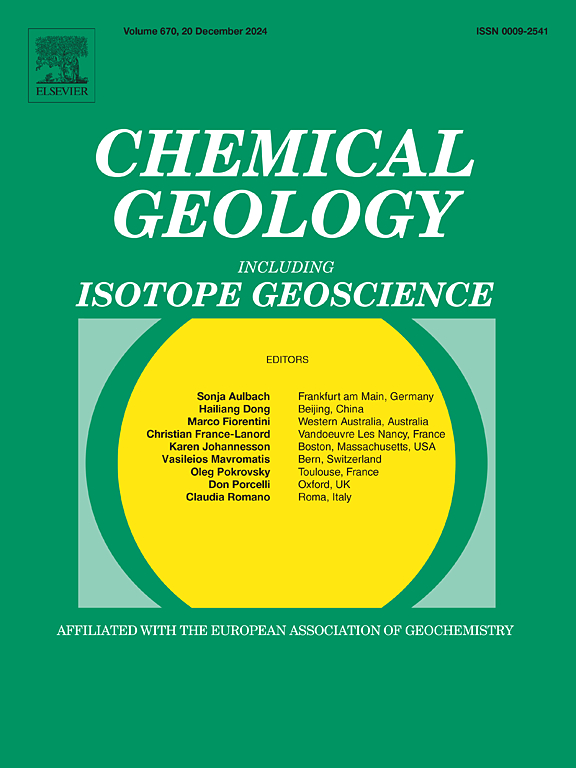甲烷通量对沉积黄铁矿微量元素地球化学影响的评价:来自南海的启示
IF 3.6
2区 地球科学
Q1 GEOCHEMISTRY & GEOPHYSICS
引用次数: 0
摘要
黄铁矿的微量元素(TE)含量已被用作海洋和沉积物孔隙流体化学的档案,这取决于各自的地层条件,并可能为了解过去的大气和海洋条件以及沉积环境提供有价值的见解。自生黄铁矿的形成主要受有机碎屑硫酸盐还原(OSR)和硫酸盐驱动的甲烷厌氧氧化(SD-AOM)的控制。虽然甲烷通量显著影响海洋沉积物TE富集,但其对黄铁矿TE地球化学的影响尚不清楚。本文研究了南海陆坡海马渗漏层重力柱塞岩心孔隙水、沉积物和黄铁矿的地球化学特征。从硫酸盐渗透深度和溶解无机碳的极负δ13C值可以看出,目前的硫酸盐-甲烷过渡带(SMTZ)位于海底以下约200cm (cmbsf)。在较浅的沉积层(超过200 cmbsf)中,古smtz的存在是由持续的低δ13C值(<;−40‰),表明在过去的渗流期甲烷通量较高。黄铁矿δ34S值相对于背景osr黄铁矿较高(−35.5‰~−6.4‰),TS/TOC比值相对于典型海相沉积物较高(0.36 ~ 1.94),表明黄铁矿形成主要由SD-AOM驱动。虽然大块沉积物中的TE富集(如Mo, U, As)仅限于20 cmbsf以上,反映了高甲烷通量条件下海水来源的TE输入,但黄铁矿TE含量在整个海流和古smtz中基本保持不变。这种缺乏可变性可能是由于局部增强的黄铁矿形成和/或有机相的竞争性TE封存的稀释效应造成的。海水TE浓度与黄铁矿TE含量之间缺乏相关性,这对使用sd - aom衍生的黄铁矿作为海水化学代用物提出了挑战。然而,黄铁矿中Mo/Cd比值的持续升高,独立于甲烷通量的变化,可以作为SD-AOM-与osr衍生黄铁矿之间的一个强有力的区别。我们的发现提高了对富甲烷沉积物TE动力学的理解,完善了黄铁矿地球化学作为古环境代用物的作用。本文章由计算机程序翻译,如有差异,请以英文原文为准。
Evaluating the impact of methane flux on the trace element geochemistry of sedimentary pyrite: Insights from the South China Sea
The trace element (TE) content of pyrite has been used as an archive of ocean and sediment pore fluid chemistry, depending on the respective formation conditions and potentially providing valuable insight into past atmospheric and oceanic conditions and sedimentary environments. The formation of authigenic pyrite is predominantly governed by organoclastic sulfate reduction (OSR) and sulfate-driven anaerobic oxidation of methane (SD-AOM). While methane flux significantly influences TE enrichment of marine sediments, its impact on the TE geochemistry of pyrite remains poorly understood. This study investigates the geochemistry of pore water, sediment, and handpicked pyrite from a gravity-piston core collected at the Haima seeps on the South China Sea continental slope. The current sulfate-methane transition zone (SMTZ) is located at approximately 200 cm below the seafloor (cmbsf), as indicated by sulfate penetration depth and the extremely negative δ13C values of dissolved inorganic carbon. The presence of a paleo-SMTZ in shallower sediment layers (above 200 cmbsf) is inferred from consistently low δ13C values (< −40 ‰) of carbonate nodules, suggesting higher methane flux during past seepage episodes. Relatively higher δ34S values of pyrite (−35.5 ‰ to −6.4 ‰) relative to background OSR-derived pyrite and elevated TS/TOC ratios (0.36 to 1.94) relative to typical marine sediments throughout the core suggest that pyrite formation was predominantly driven by SD-AOM. While TE enrichment (e.g., Mo, U, As) in bulk sediment is confined to the upper 20 cmbsf, reflecting seawater-derived TE input under high methane flux conditions, pyrite TE content remains largely invariant across the current and the paleo-SMTZ. Such lack of variability probably results from a dilution effect of the locally enhanced pyrite formation and/or competing TE sequestration by organic phases. The absence of a correlation between seawater TE concentrations and pyrite TE contents challenges the use of SD-AOM-derived pyrite as a seawater chemistry proxy. However, consistently elevated Mo/Cd ratios in pyrite, independent of methane flux variations, serve as a robust discriminator between SD-AOM- versus OSR-derived pyrite. Our findings improve the understanding of TE dynamics in methane-rich sediments, refining the role of pyrite geochemistry as a paleoenvironmental proxy.
求助全文
通过发布文献求助,成功后即可免费获取论文全文。
去求助
来源期刊

Chemical Geology
地学-地球化学与地球物理
CiteScore
7.20
自引率
10.30%
发文量
374
审稿时长
3.6 months
期刊介绍:
Chemical Geology is an international journal that publishes original research papers on isotopic and elemental geochemistry, geochronology and cosmochemistry.
The Journal focuses on chemical processes in igneous, metamorphic, and sedimentary petrology, low- and high-temperature aqueous solutions, biogeochemistry, the environment and cosmochemistry.
Papers that are field, experimentally, or computationally based are appropriate if they are of broad international interest. The Journal generally does not publish papers that are primarily of regional or local interest, or which are primarily focused on remediation and applied geochemistry.
The Journal also welcomes innovative papers dealing with significant analytical advances that are of wide interest in the community and extend significantly beyond the scope of what would be included in the methods section of a standard research paper.
 求助内容:
求助内容: 应助结果提醒方式:
应助结果提醒方式:


